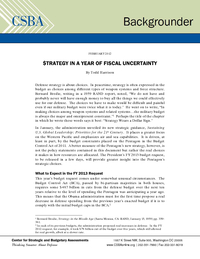
Defense strategy is about choices. In peacetime, strategy is often expressed in the budget as choices among different types of weapon systems and force structure. Bernard Brodie, writing in a 1959 RAND report, noted, “We do not have and probably never will have enough money to buy all the things we could effectively use for our defense. The choices we have to make would be difficult and painful even if our military budget were twice what it is today.” He went on to write, “In making choices among weapon systems and related systems… the military budget is always the major and omnipresent constraint.” Perhaps the title of the chapter in which he wrote these words says it best: “Strategy Wears a Dollar Sign.”
In January, the administration unveiled its new strategic guidance, Sustaining U.S. Global Leadership: Priorities for the 21st Century. It places a greater focus on the Western Pacific and emphasizes air and sea capabilities. It is driven, at least in part, by the budget constraints placed on the Pentagon in the Budget Control Act of 2011. A better measure of the Pentagon’s new strategy, however, is not the policy statements contained in this document but rather the real choices it makes in how resources are allocated. The President’s FY 2013 budget request, to be released in a few days, will provide greater insight into the Pentagon’s strategic choices.



























